seats CHEVROLET EXPRESS 1997 1.G Owners Manual
[x] Cancel search | Manufacturer: CHEVROLET, Model Year: 1997, Model line: EXPRESS, Model: CHEVROLET EXPRESS 1997 1.GPages: 386, PDF Size: 20.32 MB
Page 2 of 386
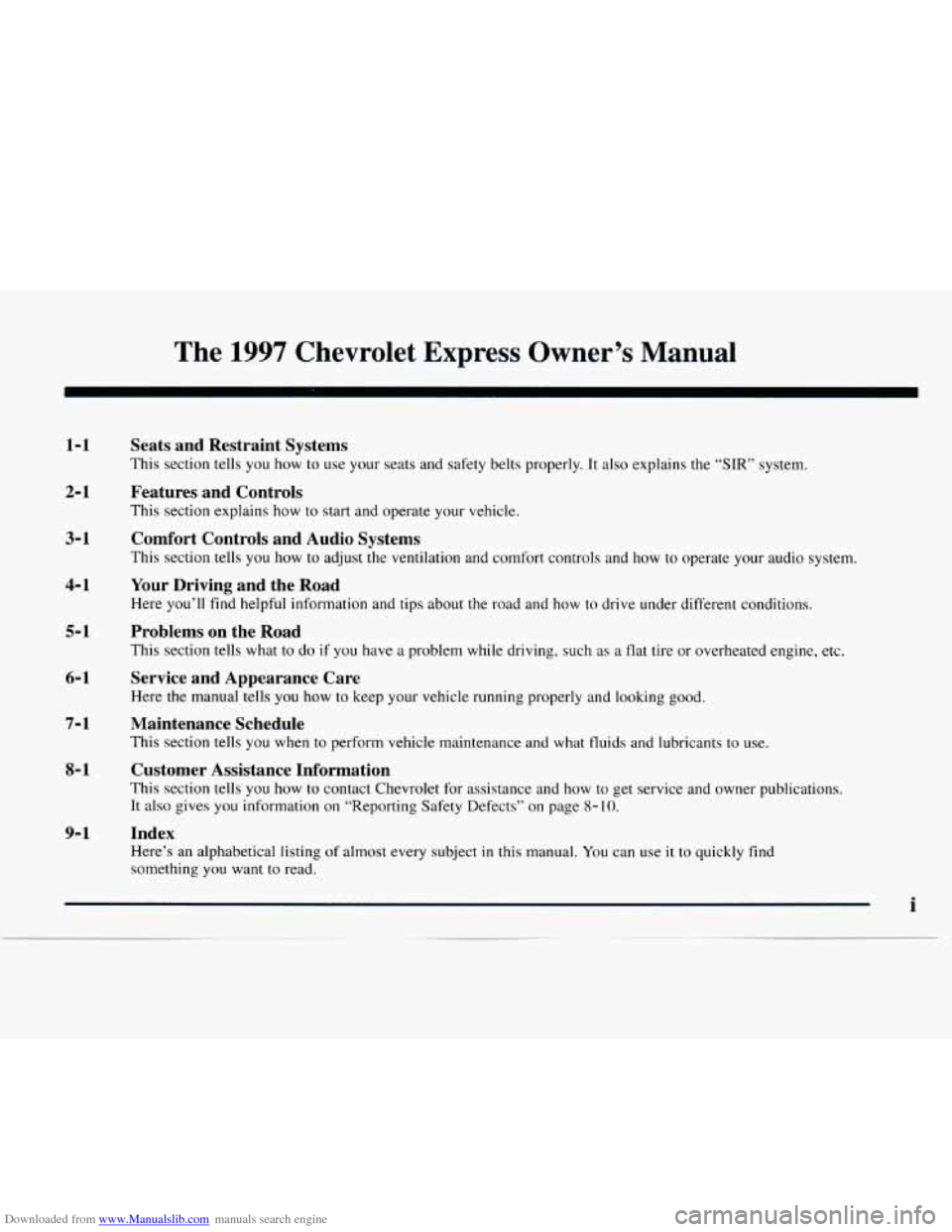
Downloaded from www.Manualslib.com manuals search engine The 1997 Chevrolet Express Owner’s Manual
1-1
2- 1
3-1
4-1
5-1
6-1
7-1
8-1
9-1
Seats and Restraint Systems
This section tells you how to use your seats and safety belts properly. It also explains the “SIR” system.
Features and Controls
This section explains how to start and operate your vehicle,
Comfort Controls and Audio Systems
This section tells you how to adjust the ventilation and comfort controls and how to operate your audio system.
Your Driving and the Road
Here you’ll find helpful information and tips about the road and how to drive under different conditions.
Problems on the Road
This section tells what to do if you have a problem while driving, such as a flat tire or overheated engine, etc.
Service and Appearance Care
Here the manual tells you how to keep your vehicle running properly and looking good.
Maintenance Schedule
This section tells you when to perform vehicle maintenance and what fluids and lubricants to use.
Customer Assistance Information
This section tells you how to contact Chevrolet for assistance and how to get service and owner publications.
It
also gives you information on “Reporting Safety Defects” on page 8- IO.
Index
Here’s an alphabetical listing of almost every subject in this manual. You can use it to quickly find
something
you want to read.
i
Page 8 of 386
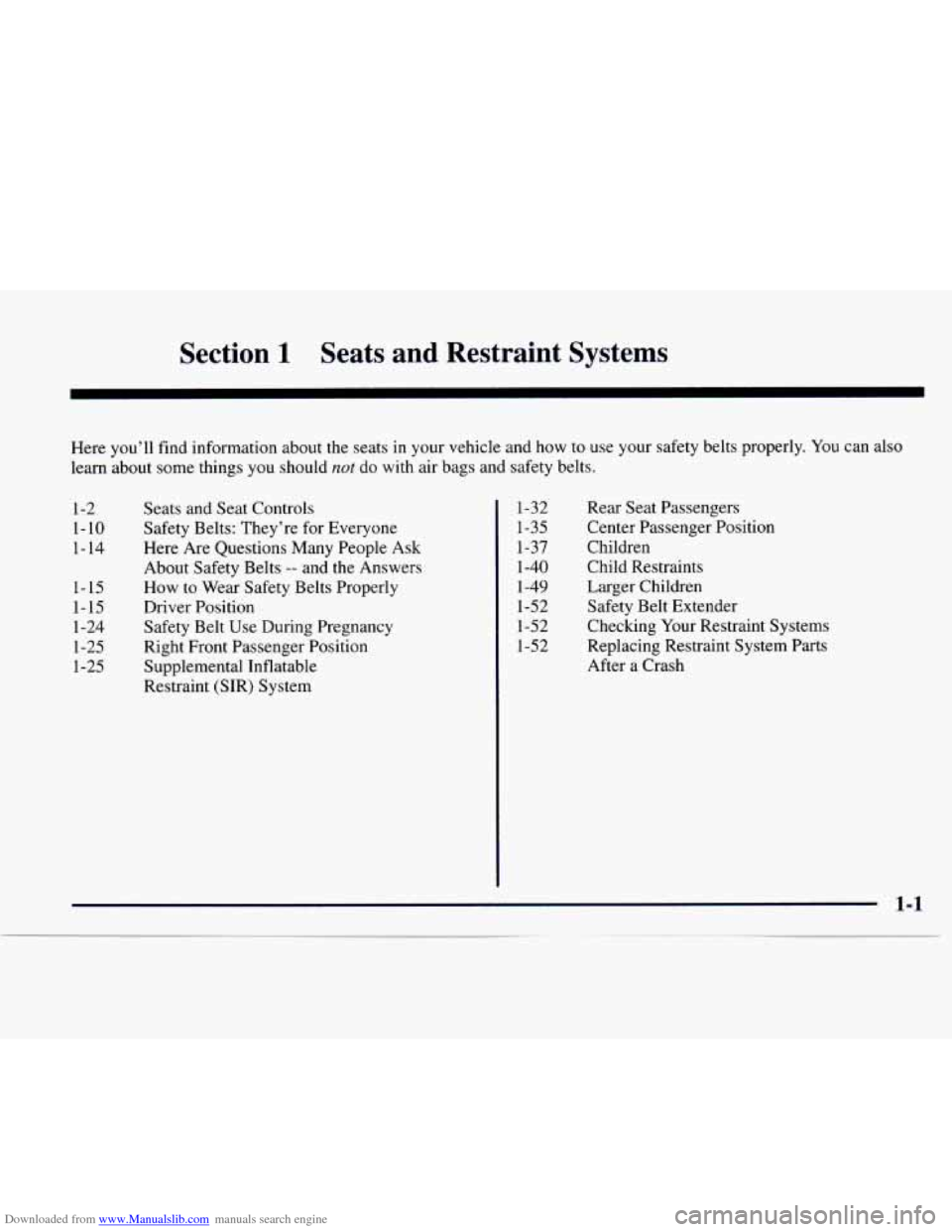
Downloaded from www.Manualslib.com manuals search engine Section 1 Seats and Restraint Systems
Here you’ll find information about the seats in your vehicle and how to use your safety belts properly. You can also
learn about some things you should
not do with air bags and safety belts.
1-2 1-10
1- 14
1-15
1-15
1-24
1-25
1-25
Seats and Seat Controls
Safety Belts: They’re for Everyone
Here Are Questions Many People Ask
About Safety Belts
-- and the Answers
How to
Wear Safety Belts Properly
Driver Position
Safety Belt Use During Pregnancy
Right Front Passenger Position
Supplemental Inflatable
Restraint (SIR) System
1-32
1-35
1-37
1-40
1-49
1-52 1-52
1-52 Rear Seat Passengers
Center Passenger Position
Children
Child Restraints
Larger Children
Safety Belt Extender
Checking Your Restraint Systems
Replacing Restraint System Parts
After a Crash
Page 9 of 386
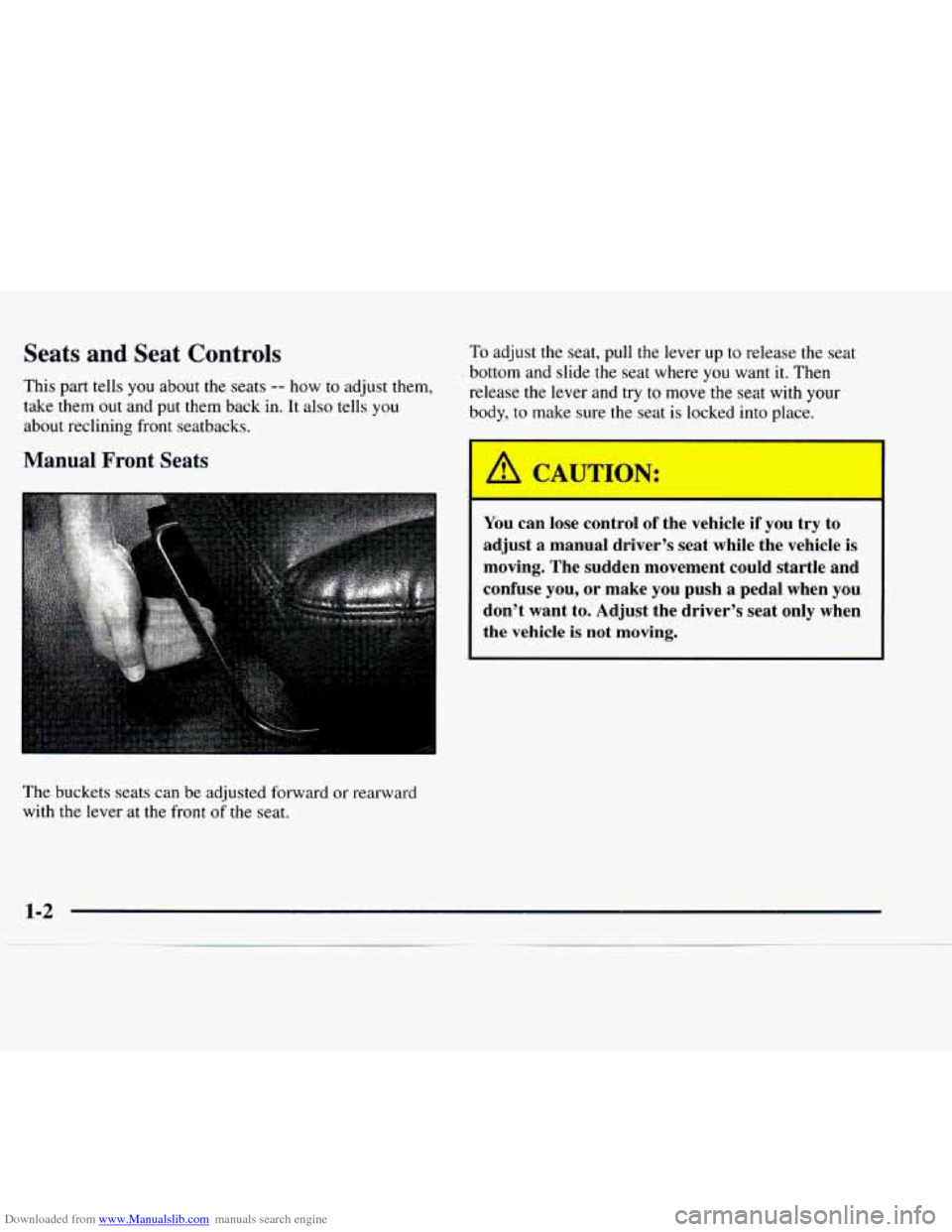
Downloaded from www.Manualslib.com manuals search engine Seats and Seat Controls
This part tells you about the seats -- how to adjust them,
take them out and put them back in. It also tells
you
about reclining front seatbacks.
Manual Front Seats
The buckets seats can be adjusted forward or rearward
with the lever at
the front of the seat.
To adjust the seat, pull the lever up to release the seat
bottom
and slide the seat where you want it. Then
release the lever and try to move the seat with your
body, to make sure the seat is locked into place.
You can lose control of the vehicle if you try to
adjust
a manual driver’s seat while the vehicle is
moving. The sudden movement could startle and
confuse you, or make you push
a pedal when you
don’t want to. Adjust the driver’s seat only when
the vehicle
is not moving.
Page 12 of 386
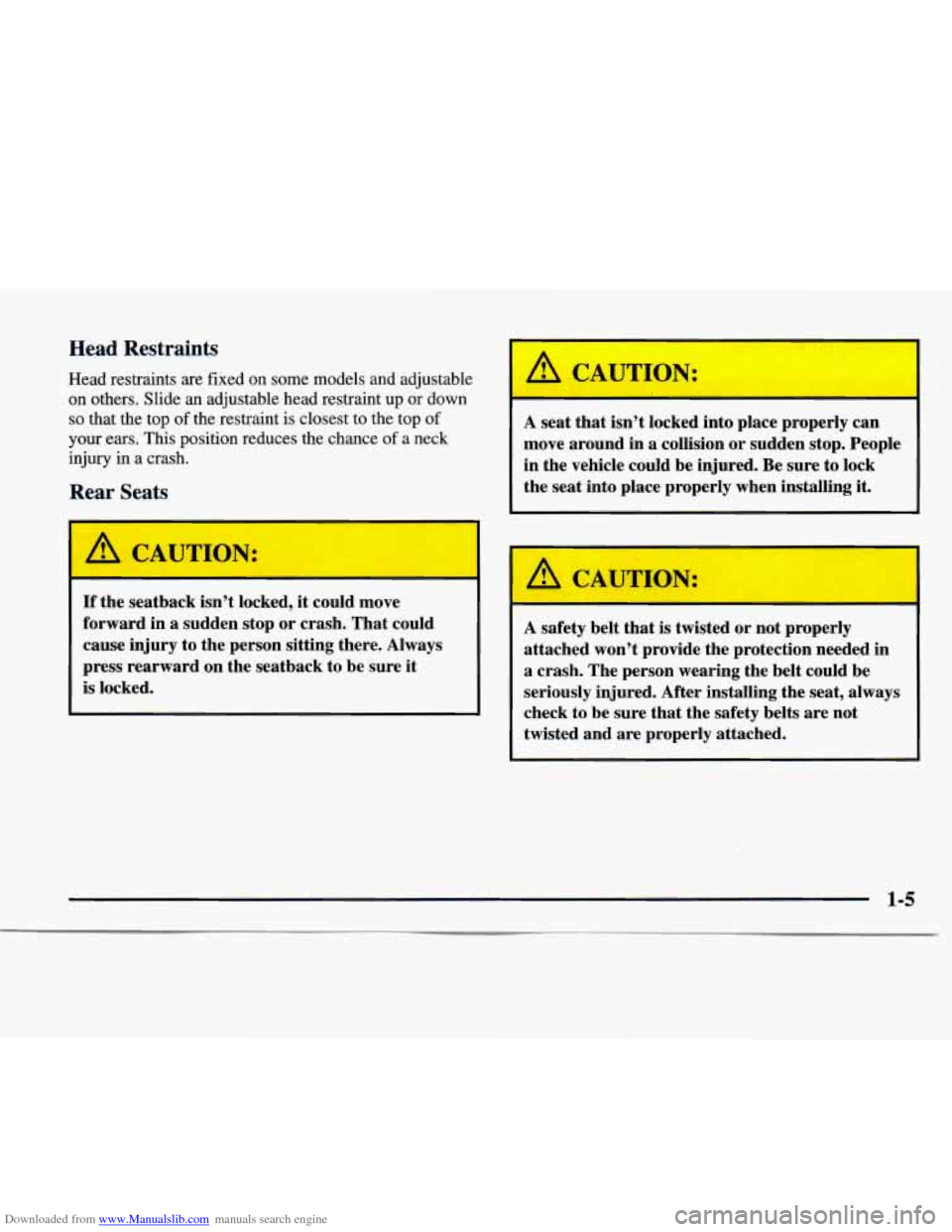
Downloaded from www.Manualslib.com manuals search engine Head Restraints
Head restraints are fixed on some models and adjustable on others. Slide
an adjustable head restraint up or down
so that the top of the restraint is closest to the top of
your ears. This position reduces the chance of a neck
injury in a crash.
Rear Seats
I A CAUTION:
If the seatback isn’t locked, it could move
forward
in a sudden stop or crash. That could
cause injury to the person sitting there. Always
press rearward on the seatback to be sure it
is locked.
A CAUTION:
-
A seat that isn’t locked into place properly can
move around in
a collision or sudden stop. People
in the vehicle could be injured. Be sure to lock
the seat into place properly when installing it.
A CAUTION:
A safety belt that is twisted or not properly
attached won’t provide the protection needed in
a crash. The person wearing the belt could be
seriously injured. After installing the seat, always
check to
be sure that the safety belts are not
twisted and are properly attached.
Page 17 of 386
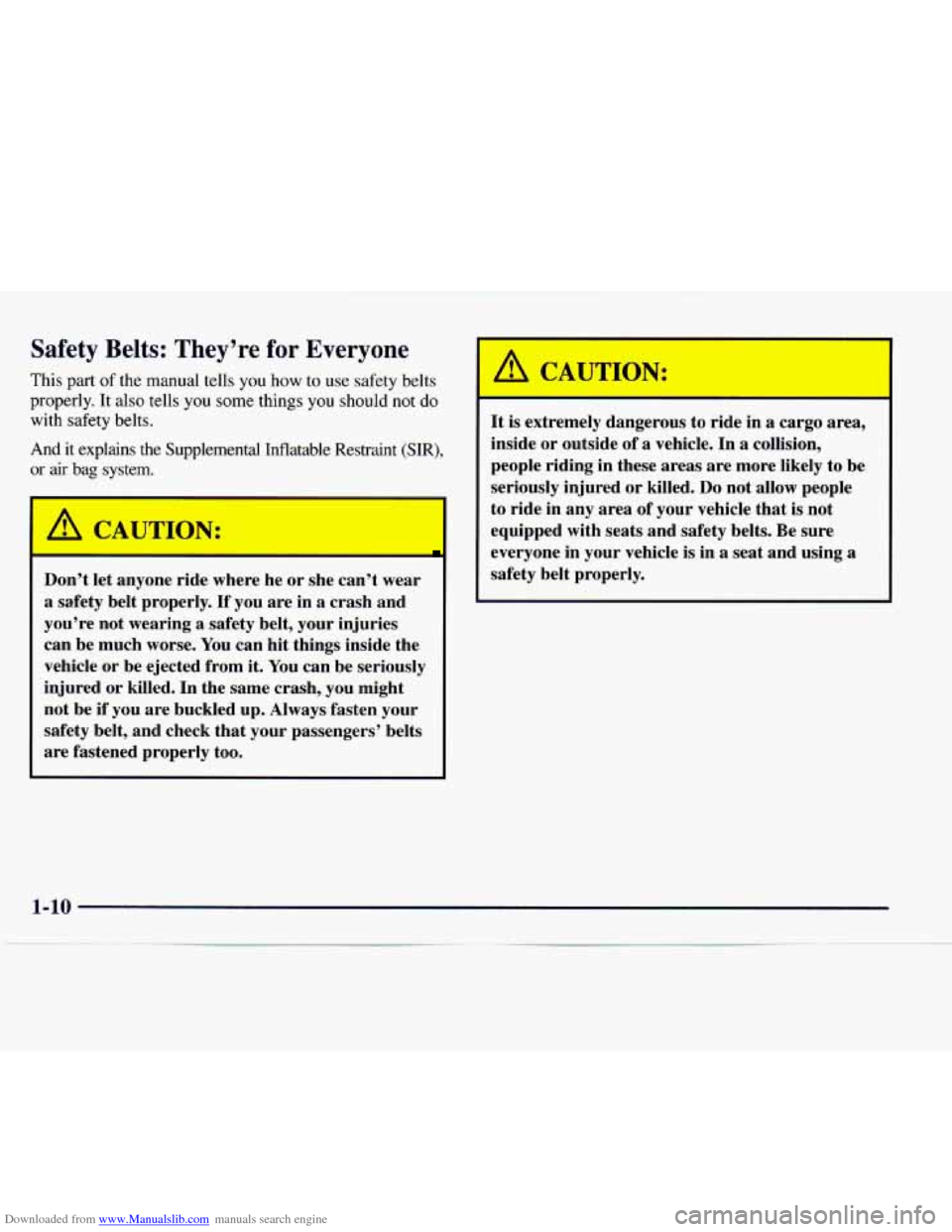
Downloaded from www.Manualslib.com manuals search engine Safety Belts: They’re for Everyone
This part of the manual tells you how to use safety belts
properly. It also tells you some things you should
not do
with safety belts.
And it explains the Supplemental Inflatable Restraint (SIR),
or air bag system.
A CAUTIOIA:
Don’t let anyone ride where he or she can’t wear
a safety belt properly.
If you are in a crash and
you’re not wearing a safety belt, your injuries
can be much worse. You can hit things inside the
vehicle or be ejected from it. You can be seriously
injured or killed. In the same crash, you might
not be if
you are buckled up. Always fasten your
safety belt, and check that your passengers’ belts
are fastened properly too.
It is extremely dangerous to ride in a cargo area,
inside or outside of a vehicle. In
a collision,
people riding in these areas are more likely to be
seriously injured or killed.
Do not allow people
to ride in any area of your vehicle that is not
equipped with seats and safety belts. Be sure
everyone in your vehicle is in a seat and using
a
safety belt properly.
1-10
Page 22 of 386

Downloaded from www.Manualslib.com manuals search engine @’ If I’m a good driver, and I never drive far from
home,
why should I wear safety belts?
A: You may be an excellent driver, but if you’re in an
accident
-- even one that isn’t your fault -- you and
your passengers can be hurt. Being
a good driver
doesn’t protect you from things beyond your
control, such as bad drivers.
Most accidents occur within
25 miles (40 km) of
home. And the greatest number of serious injuries and deaths occur at speeds
of less than 40 mph
(65 km/h).
Safety belts are for everyone.
How to Wear Safety Belts Properly
Adults
This part is only for people of adult size. Be aware that there are special things to
know about safety
belts and children. And there are different rules for smaller
children and babies. If a child will be riding
in your
vehicle, see the part
of this manual called “Children.”
Follow those rules for everyone’s protection.
First,
you’ll want to know which restraint systems your
vehicle has.
We’ll start with the driver position.
Driver Position
This part describes the driver’s restraint system.
Lap-Shoulder Belt
The driver has a lap-shoulder belt. Here’s how to wear it properly.
1. Close and lock the door.
2. Adjust the seat (to see how, see “Seats” in the Index)
so you can sit up straight.
Page 43 of 386
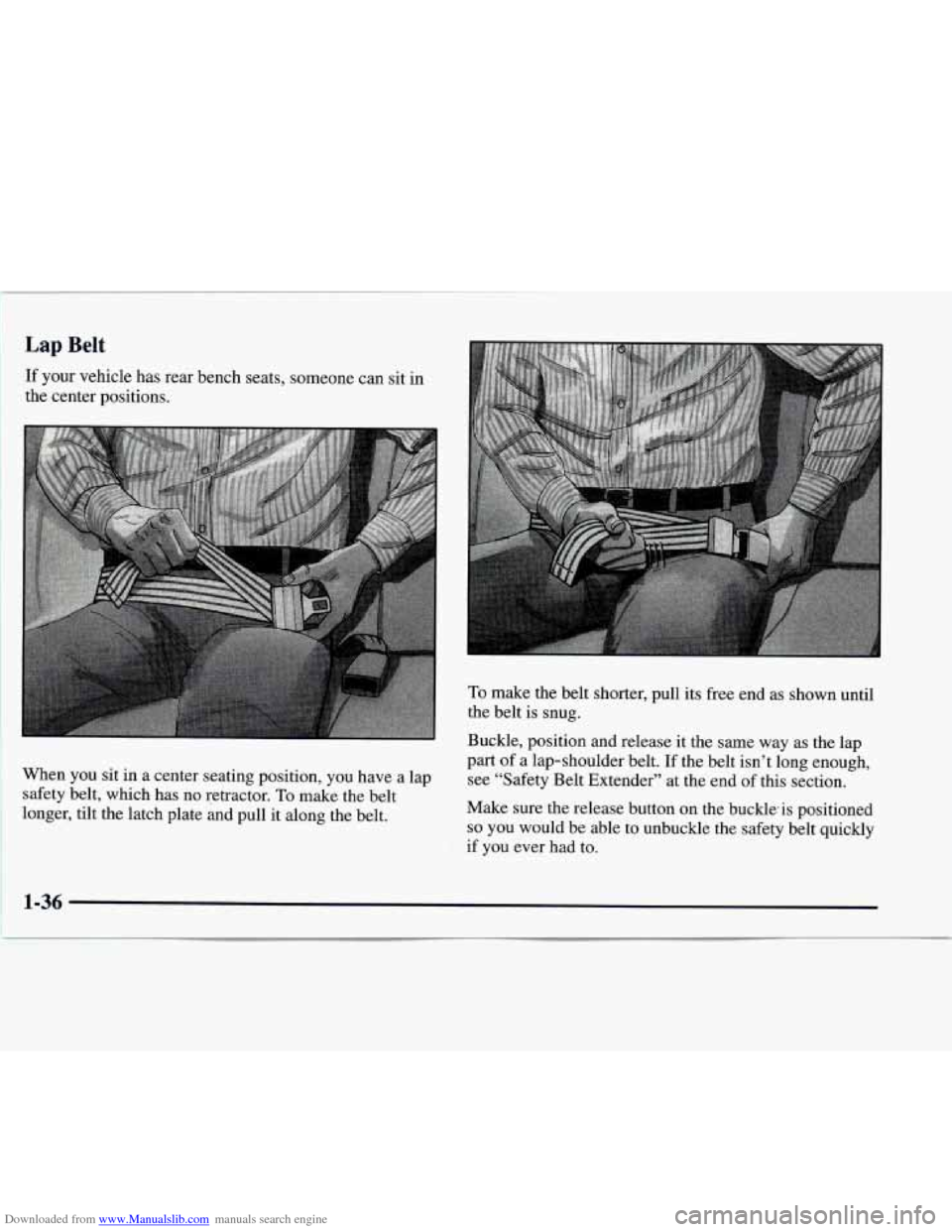
Downloaded from www.Manualslib.com manuals search engine Lap Belt
If your vehicle has rear bench seats, someone can sit in
the center positions.
When you sit in a center seating position, you have a lap
safety belt, which has no retractor.
To make the belt
longer, tilt the latch plate &d pull it along the belt.
To make the belt shorter, pull its free end as shown until
the belt is snug.
Buckle, position and release it the same way as the lap
part of
a lap-shoulder belt. If the belt isn’t long enough,
see “Safety Belt Extender” at the end
of this section.
Make sure
the release button on the buckleis positioned
so you would be able to unbuckle the safety belt quickly
if you ever had to.
1-36
I r
Page 54 of 386
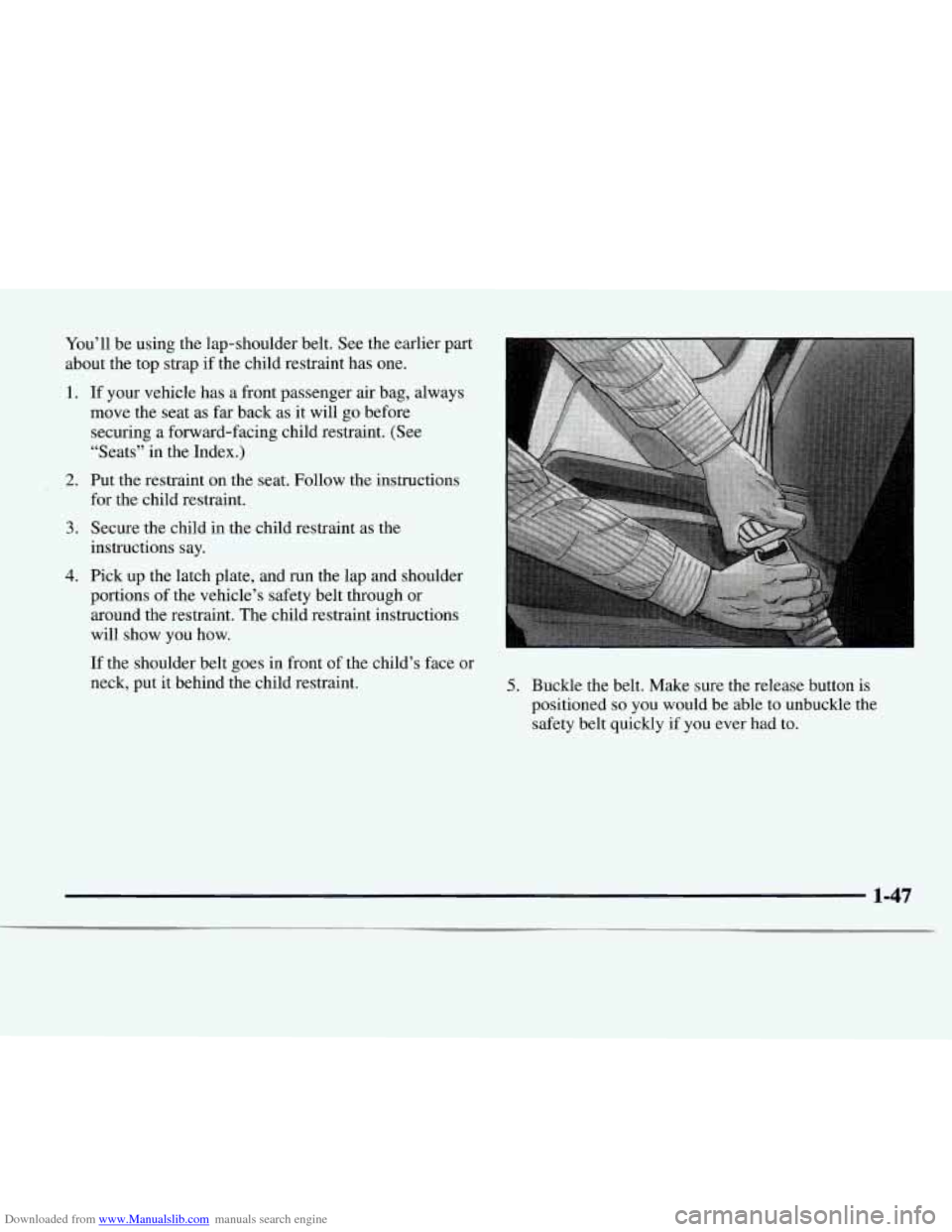
Downloaded from www.Manualslib.com manuals search engine You’ll be using the lap-shoulder belt. See the earlier part
about the top strap if the child restraint has one.
1.
2.
3.
4.
If your vehicle has a front passenger air bag, always
move the seat as far back as it will go before
securing a forward-facing child restraint. (See
“Seats” in the Index.)
Put the restraint on the seat. Follow the instructions
for the child restraint.
Secure the child in the child restraint as the
instructions say.
Pick up the latch plate, and run the lap and shoulder
portions of the vehicle’s safety belt through or
around the restraint. The child restraint instructions
will show you how.
If the shoulder belt goes in front of the child’s face or
neck, put it behind the child restraint.
.. 1
5. Buckle the belt. Make sure the release button is
positioned
so you would be able to unbuckle the
safety belt quickly if you ever had to.
1-47
Page 133 of 386
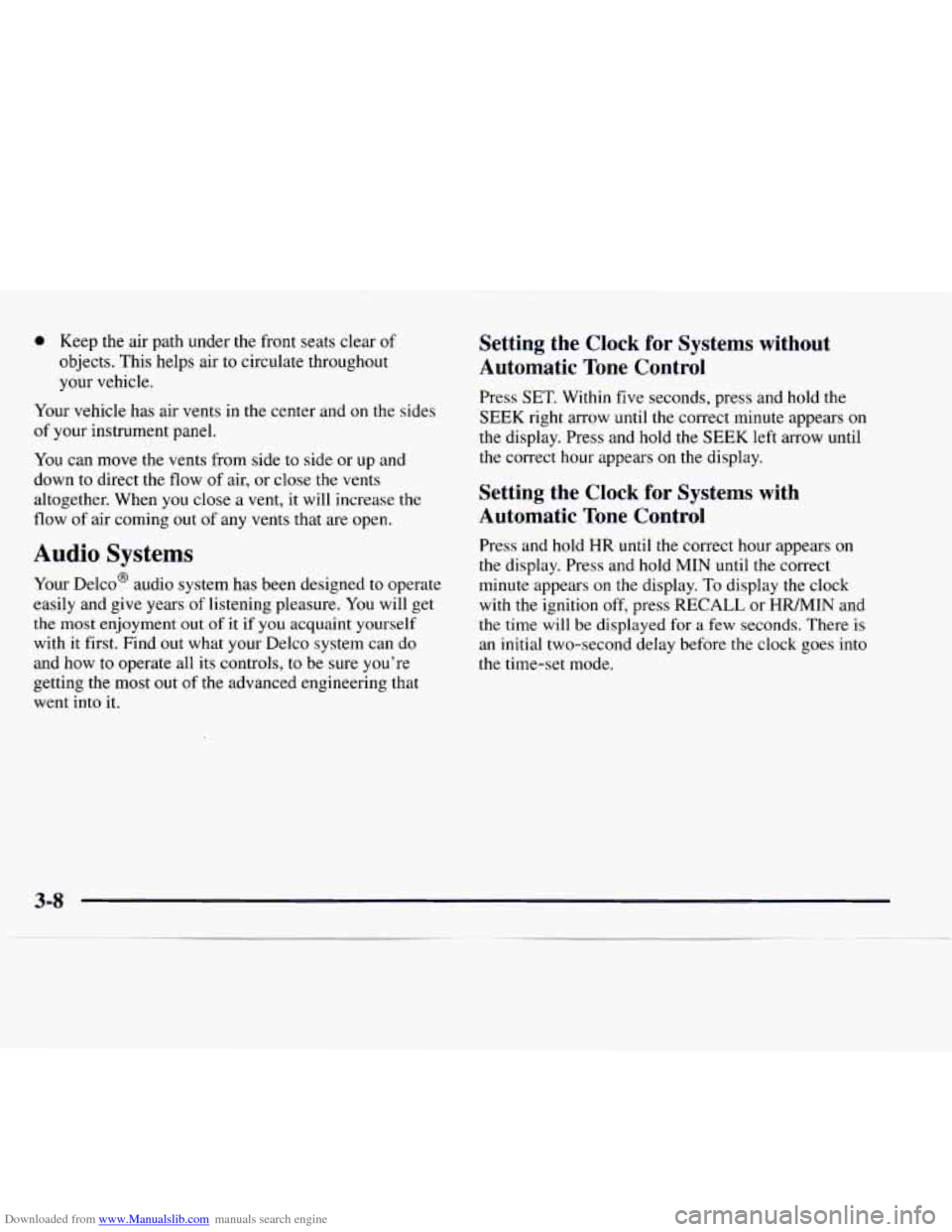
Downloaded from www.Manualslib.com manuals search engine 0 Keep the air path under the front seats clear of
objects. This helps air to circulate throughout
your vehicle.
Your vehicle has air vents in the center and
on the sides
of your instrument panel.
You can move the vents from side to side or up and
down to direct the flow of air,
or close the vents
altogether. When you close a vent, it will increase the
flow of air coming out
of any vents that are open.
Audio Systems
Your Delco@ audio system has been designed to operate
easily and give years of listening pleasure. You will get
the most enjoyment out of it if you acquaint yourself
with
it first. Find out what your Delco system can do
and how to operate all its controls, to be sure you’re
getting the most out of the advanced engineering that
went into it.
Setting the Clock for Systems without
Automatic Tone Control
Press SET. Within five seconds, press and hold the
SEEK right arrow
until the correct minute appears on
the display. Press and hold the SEEK left arrow until
the correct hour appears
on the display.
Setting the Clock for Systems with
Automatic
Tone Control
Press and hold HR until the correct hour appears on
the display. Press and hold MIN until the correct
minute appears
on the display. To display the clock
with the ignition off, press RECALL or
HRMIN and
the time will be displayed for a few seconds. There is
an initial two-second delay before the clock goes into
the time-set mode.
Page 181 of 386
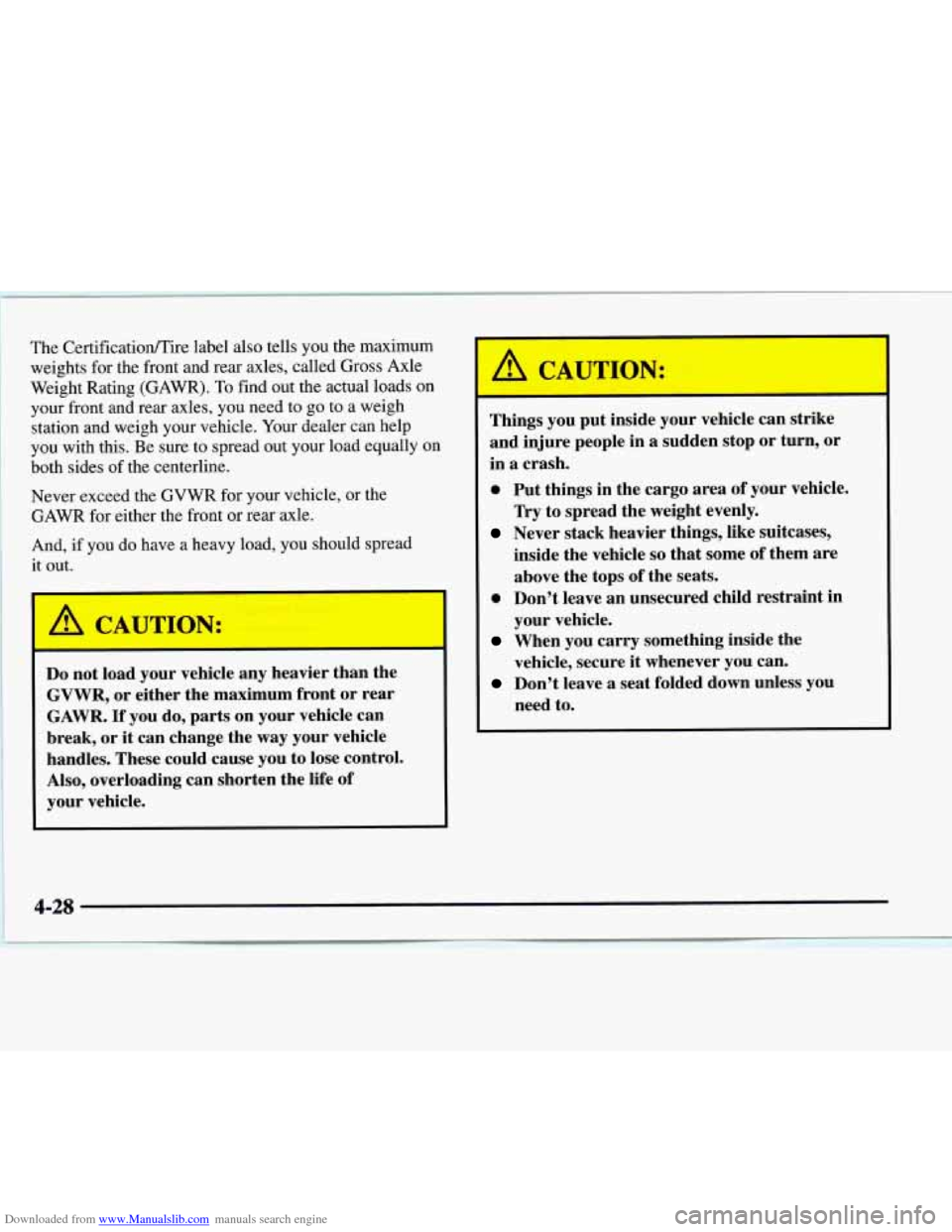
Downloaded from www.Manualslib.com manuals search engine The Certificatioflire label also tells you the maximum
weights for the front and rear axles, called Gross Axle
Weight Rating (GAWR).
To find out the actual loads on
your front and rear axles, you need to go
to a weigh
station and weigh your vehicle. Your dealer can help
you with this. Be sure to spread out your load equally
on
both sides of the centerline.
Never exceed the GVWR for your vehicle, or the
GAWR for either the front or rear axle.
And, if you do have a heavy load, you should spread
it out.
Do not load your vehicle any heavier than the
GVWR, or either the maximum front or rear
GAWR.
If you do, parts on your vehicle can
break, or it can change the
way your vehicle
handles. These could cause you to lose control.
Also, overloading can shorten the life of
your vehicle.
-
C *.UTION:
Things you put inside your vehicle can strike
and injure people in
a sudden stop or turn, or
in
a crash.
0 Put things in the cargo area of your vehicle.
Never stack heavier things, like suitcases,
Try to spread the weight evenly.
inside the vehicle
so that some of them are
above the tops of the seats.
0 Don’t leave an unsecured child restraint in
your vehicle.
When you carry something inside the
vehicle, secure
it whenever you can.
Don’t leave a seat folded down unless you
need to.
4-28